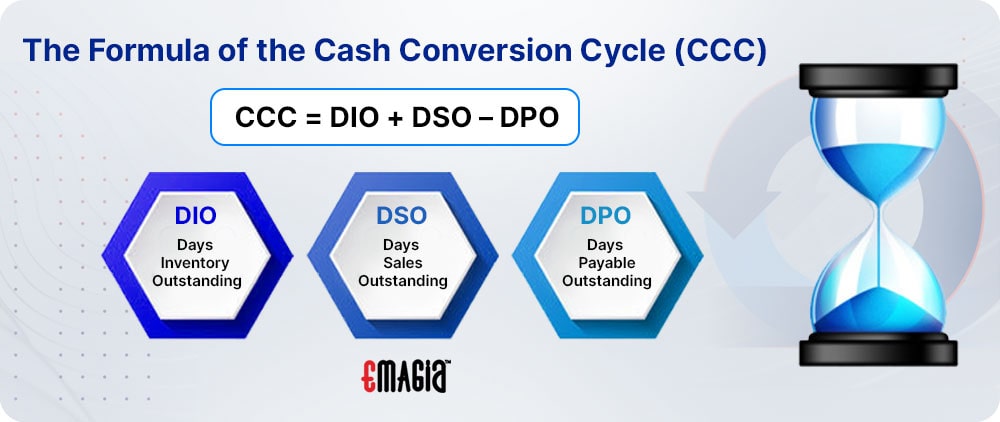The cash conversion cycle (CCC) is a fundamental financial metric that measures the time it takes for a company to convert its investments in inventory and other resources into cash inflows from sales. It serves as a key indicator of a company’s operational efficiency and liquidity management. Businesses can gain valuable insights into their cash flow dynamics, working capital requirements, and financial health. In this article, we will explore the concept of the cash conversion cycle, its significance in assessing a company’s financial performance, and the strategies for optimizing this cycle to enhance cash flow and profitability.
What is the Cash Conversion Cycle (CCC) Meaning ?
The cash conversion cycle (CCC) is a measure that quantifies the duration, in days, for a corporation to change its invested resources in inventory and other assets to cash flows from sales. The CCC is known as the net operating cycle as well. It strives to gauge the period in which every net input dollar is locked in the manufacturing and sales process before it turns into cash received.
The CCC considered the time required for the company to vend its inventory, gather accounts receivable, and settle its accounts payable. A shorter CCC is favorable because it shows the company has less cash tied up in its inventory and accounts receivable. A longer CCC shows the company requires more time to produce cash.
Understanding the CCC is crucial for businesses looking to optimize their cash flow, sales realization, and inventory management, and can help drive growth and profitability.
The Formula of the Cash Conversion Cycle (CCC) and How to Calculate It
Calculating the CCC is crucial for companies aiming to monitor cash flow, inventory management, and sales realization since it assists in assessing their operational efficiency and financial performance.
CCC = DIO + DSO – DPO
DIO = days of inventory outstanding, DSO = days sales outstanding, DPO = days payables outstanding
DIO = (avg inventory / cost of goods sold * number of days)
DSO = (accounts receivable * number of days / total credit sales)
DPO = (accounts payable * number of days / cost of goods sold)
Why is the Cash Conversion Cycle Important to the Business?
The CCC is an important metric for businesses. It measures the efficiency of a business. Monitoring it enables businesses to determine how rapidly they are converting sales proceeds into cash again. It helps owners have a clear understanding of the cash flow status of their business.
It determines the financial health of a company. By analyzing CCC, the well-being and liquidity of a company are evaluated by its primary stakeholders. The measure determines the company’s capacity to repay a business loan and fulfill other financial obligations.
It improves trade credit terms with its vendors. When deciding whether to extend trade credit to a company, vendors consider the CCC. A low CCC indicates sufficient liquidity, which increases the likelihood of obtaining favorable credit terms for the business.
CCC gets quick access to money and loans. A lower cash conversion cycle can increase the likelihood of getting business loans. A low CCC indicated there is sound liquidity. This means there is the opportunity to repay loans effectively. With this, loan approvals have a higher chance of being approved.
Interpreting the Cash Conversion Cycle
One straightforward method of visualizing the trajectory of a cash conversion cycle is through a graphical interpretation. If the CCC is declining, it is favorable because it shows that the business is converting its investments in inventory into cash efficiently. If the CCC is upward, it shows that the business is facing difficulties in its order-to-cash processes. This can result in inefficiencies and a lengthier CCC.
Keeping track of the CCC as time passes can provide us with useful insights into a business’s financial health and liquidity.
How to Use the Cash Conversion Cycle Example
The CCC does not apply to businesses that do not require inventory management, such as software companies that sell computer programs through licensing or insurance and brokerage companies that do not purchase wholesale items for retail. Some businesses can have negative CCCs like online retailers (Amazon, eBay).
These retailers receive funds for sales made by third-party sellers who use their platform, but they do not immediately pay the sellers after the sale. They follow a monthly based payment cycle. This method allows these businesses to hold on to the cash for a more prolonged period resulting in a negative CCC.
It is essential to consider the business model when calculating the CCC. All companies may not have similar inventory management requirements. Online retailers can have negative CCCs. Regular retailers can have positive CCCs. The difference between these is crucial for assessing a business’s financial health and liquidity.
How to Improve the Cash Conversion Cycle?
Effective management of payables is crucial for maintaining control over working capital. By consolidating spending and enhancing supplier collaboration, businesses can improve their CCC and gain positive trends. As a business owner, negotiating payment terms with suppliers is a viable option to optimize payables management.
Caution should be taken to prevent jeopardizing the stability of the supply chain. Delaying payments can also harm relations with suppliers which is not the best for the long term.
Inventory Turnover Affects Cash Conversion Cycle
CCC is affected by the speed of inventory turnover, which tells how quickly a company can generate revenue from its inventory assets. A high inventory turnover rate results in a lower CCC. A low inventory turnover rate results in a higher CCC.
The CCC measures the time it takes for a business to purchase inventory and receive payment from sales. Reducing the time between these two situations allows for a company to improve its CCC and increase its cash flow. The longer duration between these two situations can harm the CCC implications regarding the cash flow.
Conclusion
In conclusion, the cash conversion cycle is a crucial metric for businesses to manage their working capital and financial health. It shows how efficiently a company is converting its investments in inventory and resources into cash flows from sales. It also shows how long each net input dollar is tied in the product sales process before it gets converted into cash.
Maintaining a healthy CCC is essential for obtaining credit terms and obtaining business loans. These two are crucial for increasing growth and expansion. A shorter CCC means less cash is tied in inventory which improves liquidity and reduces financial distress. A longer CCC means possible inefficiencies in the supply chain which leads to cash flow problems and reduces the business’s ability to invest in growth opportunities.
FAQs
What Does the CCC Measure?
CCC measures how efficiently a company can transform cash into more cash.
What is a High CCC?
If clients need 30-90 days to pay you, you have a high CCC.
Is it Better if Your CCC is High or Low?
It is better if your CCC is on the lower end.
What is the Best Type of CCC?
Having a negative cash conversion cycle is advisable for businesses.
What is the Benefit of having a Low CCC?
When you have a low CCC, you have better liquidity.





